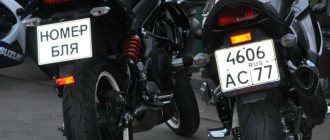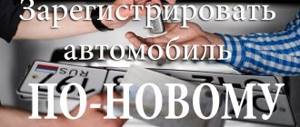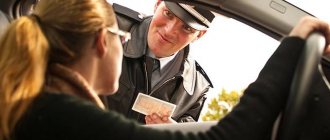Legality of tuning
So, the question of whether it is possible to install a spoiler, bumpers, non-original alloy wheels and other body kit and tuning elements, a muffler, a guard and other parts not provided by the factory on a car is regulated by 3 regulations:
- Technical Regulations of the Customs Union on vehicle safety (hereinafter referred to as the “Technical Regulations”),
- Federal Law on Vehicle Registration (hereinafter referred to as the “Order”),
- finally, traffic rules.
And we will start with the latest legal act - the Rules clearly tell us that if changes are made to the design of a car without registering them with the traffic police, then we cannot operate such a car.
7.18. Changes have been made to the design of the vehicle without permission from the State Road Safety Inspectorate of the Ministry of Internal Affairs of the Russian Federation or other bodies determined by the Government of the Russian Federation.
From June 1, 2021, Government Decree No. 413 comes into force. The procedure for making changes to the design has not changed, but the procedure itself has become clearer and more regulated.
But why should the above tuning elements be changed?! And since this is exactly what the Technical Regulations say. It has a clear definition of making changes:
Making changes to the design of a vehicle - exclusion of components and equipment not provided for by the design of a particular vehicle, made after the vehicle is put into circulation and affecting road safety;
All that remains is to understand what the components of the car are. And here the regulations have a clear answer to the question:
Vehicle components - components of the vehicle structure supplied to the assembly production of vehicles and (or) as replacement (spare) parts for vehicles in operation;
What does not apply to tuning?
Also, paragraph 77 says that if the manufacturer has provided for the installation of a certain component or it has passed a conformity assessment as part of the car (safety tests), then its installation is possible:
77. Vehicles are not subject to inspection in the following cases:
- when installing on a vehicle components intended for this vehicle and having passed the conformity assessment as part of this vehicle, which is confirmed by the documentation of the component manufacturer;
- provided by the vehicle manufacturer in the operational documentation;
Thus, in order to answer the question about the legality and fine for a muffler, bumpers, alloy wheels, roof fairings, tow bar, roof rack and other tuning elements, we need to understand 2 things: are they provided for or not by design, do they influence they are on road safety.
But there is another important auto subtlety - the Technical Regulations contain an exhaustive list of components regulated by it. Does this mean that if some component is not regulated by this legal act, then it can be installed in any case, and it is no longer a component according to the letter of the law?
This is where disputes often arise between car lawyers. And the logic should still be followed: the regulations clearly prescribe what a design change is and that the components must pass tests as part of the car and be certified, and even if, for example, a spoiler is not regulated by the regulations (and also, on the one hand, is not component, since it is not included in the list of components; on the other hand, by definition of a design change, it is still prohibited), this still does not mean that it can be installed.
You will also be interested in:
- Is athermal tinting prohibited according to GOST and what is the fine?
- Is it possible to install eyelashes and DRLs on headlights according to traffic regulations and what is the fine for this?
- How much are fines for wheels and tires? All possible violations
What should owners of cars whose design has already been modified do?
According to the Technical Regulations of the Customs Union (Section 4, Chapter V) “On the safety of wheeled vehicles,” in the event of a change in the design of a car, its owner is obliged to conduct a preliminary technical examination and safety check of the design of the vehicle after making upgrades (tuning) to it. Such checks and examinations are possible and can only be carried out by accredited testing laboratories that are included in the Unified Register of Organizations that carry out certification and testing based on laboratories in the territory of the Customs Union.
The unified register of certification bodies and testing laboratories of the Customs Union can be viewed on the official website of the Eurasian Economic Commission. Here is the official website address: https://www.eurasiancommission.org/
This is a section of the Department of Technical Regulation and Accreditation of the Eurasian Economic Commission. On their section of the website you can also familiarize yourself with other important documents related to road safety and operation of vehicles in the territory of the Customs Union.
Fake about the new tuning law of 2021
Updated 02/01/2021 due to changes in the rules for making design changes.
Meanwhile, a myth is spreading online that new rules for modifying vehicles are supposedly being introduced. Some sources claim that the changes come into force on February 1, 2021, while others claim that the new law comes into force on March 1.
The main provisions outlined by these sources are as follows:
- allegedly, from February 1, 2021, new rules for car tuning come into force, and now any additional components must be included in the documents and officially registered with the traffic police,
- at the same time, a certain new GOST is mentioned, a link to which none of the sources provides,
- it is also reported that the amendments were supposed to come into effect 2 years ago, but they were postponed just to February 1,
- if previously the inspector had to detect and prove illegal changes in the design of the car, now it is enough for him to blame the driver, and the car enthusiast is obliged to prove that no such changes were made,
- cars with illegal tuning simply will not be able to pass inspection,
- and traffic police officers will be able to confiscate STS if such a violation is detected right on the road.
There are so many “facts”, you can get confused!.. Which, in general, was successfully done by those who write such the latest news about the new tuning law.
Really?
It's quite easy to figure it out here. Indeed, several regulations regarding design changes have recently come into force, and a couple more are pending.
Even 2 years ago, indeed, a new document was developed with the rules for making changes to the design of a car - this is the Decree of the Government of the Russian Federation No. 413. Almost the entirety of this act also came into force in 2021, with the exception of 2 provisions:
- if there is no conclusion of a preliminary examination of the changes (read as tuning), then the traffic police is obliged to make a decision to refuse their registration (subparagraph “e” of paragraph 7 of the said PPRF),
- There will also be a refusal to issue a registration certificate if the registry does not have a vehicle inspection protocol after the changes have been made (subparagraph “d” of paragraph 10).
“Proof” that these 2 paragraphs come into force exactly from February 1, you can find, for example, on the Garant website (the “Additional Information” tab - the effective dates of individual provisions of this Resolution are indicated here):
Another new law concerns not directly tuning, but technical inspection. These are corresponding amendments to the official regulatory act. And here everything is even simpler, but more fateful for some car owners:
- from March 1, 2021, a traffic police officer has the right to cancel a diagnostic card if it turns out that the owner did not undergo a technical inspection, but bought it,
- the rules for vehicle inspections are being tightened,
- In addition, a number of sources write that inspectors will be given the right to confiscate STS right on the road if it turns out that changes in the design of the car are illegal - however, there are also no links to official sources, so it is too early to talk about this.
What is considered tuning by law?
Tuning is a broad concept that includes modifications to the design of a vehicle in order to improve its quality characteristics, namely:
- Changing the appearance of the car, for example, stickers, airbrushing or interior (covering seats, ceiling with various materials, connecting additional functions).
- Installation of systems that allow you to increase the speed of a car by increasing engine speed and torque arm. In this case, the engine is affected, and, as a rule, pistons, valves, exhaust systems and other parts must be replaced, which helps reduce losses.
- Chip tuning is modifications in electronics that affect the power of a vehicle without making changes to the engine.
- Changes to vehicle components and assemblies (most often used by street racers). It involves modifying the suspension by installing shock absorbers, springs, stabilizers, which makes the car more stable and maneuverable. Also, adjustments are made to the brake system - high-temperature brake pads with a high level of friction, larger diameter discs, etc. are introduced.
What to do if your car has been towed - where to call the driver?
Is it possible to install non-original bumpers?
Now let's look at each of the tuning elements - whether it can be installed or not according to the law, and below we will look at fines and other risks (they exist), if this is prohibited - the fine is the same and is imposed for changing the design of the vehicle.
Vehicle bumpers are included in the list of components of the Technical Regulations. That is, this is the composition of the car, it is an integral part of it. And it definitely affects road safety (especially with regard to the consequences of accidents with pedestrians).
So, sports bumpers can be installed if they meet several conditions:
- comply with the UNECE Bumper Regulation (see figure below),
- have passed safety tests as part of your car model (in other words, these must be original bumpers).
If at least one condition is not met, then changes to the design will have to be made officially through the traffic police.
How to arrange car tuning or any similar changes made to the design?
According to current legislation, any changes to the design of the vehicle must be certified and registered with the traffic police. To do this, you need to go through the procedure in accordance with the Technical Regulations of the Customs Union on vehicle safety No. 877 dated December 9, 2011.
That is, the owner of a car who has made changes to the design of his vehicle must undergo 2 checks in specialized organizations and then, in the event of a positive decision of the examination on the safety of the vehicle, formalize the appropriate changes in the traffic police authorities, which will be made by these authorities in special marks of the passport vehicle, where certified design changes made to the vehicle will be noted.
Attention! Friends, we draw your attention to the following: the State Traffic Inspectorate does not certify tuning or any other changes made to the body structure. According to the current legislation, the traffic police authorities are only involved in issuing permission to install additional equipment in a car.
Is it possible to install a sports muffler?
Yes, again, if it meets the above two requirements. But there is one more requirement for the muffler - noise standards.
And again the Technical Regulations intervene in the matter. For passenger cars, the maximum noise level is 96 decibels. If during measurement (and traffic police officers have the means to take measurements) it turns out that your replaced muffler produces more, then this is already a fine of 500 rubles under Article 8.23 of the Administrative Code.
Muffler
But this item is no longer regulated by regulations, so certificates of compliance are not required for it. Another thing is that the noise level should also be normal.
What tuning and modifications can be installed
Everything that is considered a component of the car will have to be tested and registered. This:
The legality of vehicle design changes from July 1 will be assessed in accordance with GOST 33670–2015 .
Explanations from Za Rulem on individual modifications/tuning:
About wheel size
: Information about what wheel size can be used is contained in the owner's manual and documents issued during vehicle certification before sales in the country - VTTS (Vehicle Type Approval) and VSKTS (Vehicle Safety Design Certificate). More detailed explanations.
About the
roof
: The ban applies only to homemade roof racks. There will be no questions for owners of cars with factory-produced, mass-produced luggage racks certified by manufacturers. Moreover, this is a quick-detachable design, and not a car conversion.
About the trailer hitch (towbar)
: This is also a quick-release design. They are subject to certain requirements, but if the product is factory-made and certified, there should be no claims against the car owner. More detailed explanations.
About LED license plate lights
. Clause 3.4 prohibits the installation of lenses and lamps that do not correspond to the type of this lighting device. So, if the manufacturer has prescribed the use of, for example, W5W 12V 5W incandescent lamps in the backlight, others cannot be used.
About installing seats from another car
: Depends on what car and what seats. Such a replacement may be considered a conversion, but you are eligible if you provide documentation that the seats are safe and can be installed in your vehicle. The work must be performed in a specialized workshop (car service) and registered with the traffic police.
About the spare tire outside
: GOST 33670–2015 contains paragraph A.26.10, indicating that the spare wheel, batteries, and seats must be securely fastened in the places provided by the manufacturer.
About a non-standard muffler (spider, etc.)
: GOST 33670–2015 (clause A. 23.2) indicates that changes to the design of the exhaust gas system are not allowed. The maximum noise levels for the exhaust of vehicle engines are also regulated, and cars with “direct flow” are usually very loud.
About engine chip tuning
: There is still no direct ban on it. The main thing is that the electronic engine control units do not have visible damage and that the content of harmful emissions in the exhaust gases does not exceed the norm.
About mud flaps that don't come from the factory
: The list of faults prohibits operation if the vehicle does not have the rear protective device, mudguards and mud flaps provided for by the design. But if those that are not provided for are present, this is not a violation. At least not directly. It is unlikely that inspectors will bother with you on such a dubious matter.
About the non-standard radio (Teyes, etc.)
: A non-standard head unit does not change the design of the car (unless you have completely redone the power supply system).
About a non-standard steering wheel (sports steering wheel, etc.)
: In the List of malfunctions and conditions under which the operation of vehicles is prohibited, the type of steering wheel is not regulated, in contrast to play, movement of components and parts, threaded connections, the presence or absence of power steering or steering dampers, and steering column fixation devices. The same as in GOST 33670–2015 “Single motor vehicles. Methods of examination and testing for conformity assessment." It states that the steering wheel should not catch part of the driver’s clothing or jewelry, the steering wheel mounting bolts to the hub should not protrude, you can use a steering wheel with metal spokes (rounded) - and that’s all.
However, the List contains clause 7.18, which states that operation may be prohibited if “changes are made to the design of the vehicle without permission from the State Road Safety Inspectorate of the Ministry of Internal Affairs of the Russian Federation or other bodies determined by the Government of the Russian Federation.” And this item is for traffic cops - for all occasions. However, they must still prove that you actually made changes to the design of the vehicle.
About installing HBO
: As before, the alteration will have to be registered with the traffic police (through examination by NAMI or other expert companies).
About wind deflectors (side deflectors)
: You can install it. But, according to GOST 33670–2015 (A.16.6), they must not be bent towards the body so that their edges cannot come into contact with a ball with a diameter of 100 mm (imagine a large Christmas tree ball), and have a radius of curvature of the edges of at least 1 mm. Difficult? This is not your problem, but the experts’, if they suddenly have to prove the illegality of your deflectors.
Is it possible to install alloy wheels?
Alloy wheels are not a vehicle component regulated by the Technical Regulations... But the bolts or nuts are - and on aftermarket alloy wheels they are usually different from stock or stamped ones.
Thus, alloy wheels must also be properly certified by the UNECE Regulations and also be tested as part of your car, and only then can they be installed under the 2021 law.
Is it possible to hang a spoiler?
Spoilers are not included among the car components in the regulations. Does this mean that its installation is legal? In general and in general, yes. The spoiler, therefore, is just an accessory, a periphery to the car, and not its component, it does not affect safety in any way, therefore, its installation is legal, and no certificates of conformity are required for this.
There should be no fine for installing a spoiler. However, in practice, on the road, traffic police inspectors can easily demand to see documents for it.
Tinting: ban and strict sanctions in the future
GOST tells us: “The light transmission of glass that provides visibility to the driver from the front must be at least 70% for windshields and for glass that is not windshield, but provides visibility to the driver from the front and rear.” As for the windshield, a tinted strip in the upper part up to 14 cm wide is allowed for passenger cars.
If the tinting does not comply with the requirements of technical regulations, the driver will be fined 500 rubles. and order it to be removed. By the way, these are flowers and berries: from July 1, 2012 to November 15, 2014, license plates were removed for this violation. It is possible that in the near future the fine for tinting will increase to 1,500 rubles, and if the motorist is caught again, he will have to pay 5,000 rubles.
Is it possible to change the suspension: shock absorbers or springs?
No. They are vehicle components and are strictly regulated by law. Accordingly, replacement of suspension components is possible only if there is an assessment of their compliance with your model by the manufacturer of your car, as well as compliance with the UNECE Rules.
This component also directly affects road safety.
Illegal alteration of optics
For trying to improve the illumination of the road with LED bulbs or non-standard “collective farm xenon”, the driver will not get off with a 500-ruble bill - this type of tuning will send him to the “spare bench” for a period of 6 to 12 months. The Code of Administrative Offenses states: “Driving a vehicle on the front of which are installed lighting devices with red lights or red reflective devices, as well as lighting devices, the color of the lights and the operating mode of which do not comply with the requirements of the Basic Provisions for the admission of vehicles to operation and the duties of officials persons responsible for ensuring road safety - entails deprivation of the right to drive vehicles for a period of six months to one year with confiscation of the specified devices and accessories.”
By the way, theoretically they can also find fault with the luminous strip under the thresholds and bumpers in the “afterburner” style, especially if the light is not directed strictly downwards, and its color does not comply with the regulations. That is, if a scarlet glow emanates from under the front bumper, and the rear glows green.
What is the punishment for illegal tuning?
If you installed tuning elements: wheels, bumpers or any other elements without the approval of the traffic police and if they cannot be installed by law without such approval, then you will face at least 2 sanctions.
Something else useful for you:
- Is it possible to knock out the catalyst? What are the consequences: fine and technical inspection?
- Is it possible to install a kenguryatnik on Niva and other cars?
- How to make changes to the design of a car officially?
Tuning fine for 2021
If you installed tuning elements not in accordance with the Technical Regulations, then you are subject to a fine of 500 rubles under Part 1 of Article 12.5 of the Administrative Code - this sanction provides for any non-compliance with the conditions under which the operation of cars is prohibited. Above we quoted clause 7.18 of this list of conditions about making changes to the design.
This fine can be paid with a 50% discount within 20 days from the date of the decision.
But a fine is the lesser evil in the matter of illegal tuning.
Cancellation of registration
It happens very simply - a traffic police officer on the road identifies a violation, writes a report to the boss, and based on the results of the report, he makes a decision to terminate the registration of the vehicle. In this case, the license plate number and registration certificate of the car are canceled and put on the wanted list.
The legal basis for termination of registration of the traffic police is provided by the above-mentioned new law on registration in the totality of its articles 18 and 20:
- subparagraph 4 of paragraph 1 of Article 20 prescribes that when changing the design, registration actions cannot be carried out,
- subparagraph 6 of paragraph 1 of Article 18 indicates that if there are grounds for which registration actions are not carried out, then a car already registered with illegal tuning is subject to forced termination of registration.
In such a situation, the car owner will have to remove the illegal tuning, come to the traffic police for an inspection and re-register the car, paying the state duty for STS and GRZ and receiving new license plates.
Tuning for the “disenfranchised”
There are other modifications that make the driver a pedestrian, or are subject to a large fine. By the way, not all of them are of a technical nature:
- installation of a light (flashing lights) and sound signal on the roof (deprivation of a driver’s license for 1-1.5 years)
- painting a car in the colors of the operational service (deprivation of a driver’s license for 1-1.5 years)
- painting a car the color of a taxi (fine in the amount of 5 thousand rubles) illegal use of the “disabled person” sign (fine in the amount of 5 thousand rubles)










